|
IT is related by Sir John Graham
Dalycli how in 1818, one John Campbell from Nether Iorn, brought "a
folio in MS., said to contain numerous compositions," for the inspection
of the judges at the annual piping competition held in Edinburgh under
the auspices of the Highland Society the story goes on, "but the
contents merely resembling a written narrative in an unknown language,
nor bearing any resemblance to Gaelic, they proved utterly
unintelligible. Amidst many conjectures relative both to the subject and
the language, nobody adventured so far as to guess at either airs or
pibrochs." It is believed that this is the earliest authentic reference
to the pipers notation known as Canntaireachd, and it is of interest to
note that even as early as 1818, among the class of Highland gentlemen
who acted as judges at the biggest competition in the country, the very
existence of the notation was unknown. Sir John mentions also that he
made later attempts to acquire this MS. volume and to trace two others
in the possession of John Campbell's father : his attempts were
unsuccessful.
In 1828
Captain Macleod of Gesto published some pipe tunes in Canntaireachd as
taught by the MacCrimmons in Skye. The merits of this publication have
been made the subject of controversy among pipers and others; this
controversy has no place in this paper. The late John Campbell (lain
Ileach) of Tales of the West Highlands, wrote a monograph on
Canntaireachd in 1880, in which he reviewed Gesto's book: the monograph,
interesting as it is and written in lain Ileach's easy flowing style is
extraordinarily disappointing. In spite of his comprehensive knowledge
of folk-lore--more particularly of Gaelic folk-lore--he fails to
indicate any probable source of this notation—probably no one in Europe
was, or is better fitted to make conjectures on the point. However, he
made two statements of interest in the late history of the notation, (1)
that he had often seen my nurse John Piper reading and practising music
from an old paper manuscript, and silently fingering tunes. I have tried
to recover this writing, but hitherto in vain, and (2) that there were
three local varieties of the notation (a) MacCrimmon (b) MacArthur, and
(c) Campbell of Nether Lorn. Now "John Piper" was this same John
Campbell of the family of Nether Lorn, which possessed three MS. volumes
of Canntaireachd.
Among
the older-fashioned pipers in Scotland, even just before the war, one
constantly heard syllables (hodroho, hiodro, etc., etc.) being used,
generally at haphazard, seldom in their correct place. The astounding
thing is that even fragments of a notation, the system of which had been
out of use for so long, should have survived to this day.
About 1912 two of the Nether Lorn MS. books were
rediscovered, and from them it has not been hard to reconstruct the
system of notation. Those tunes with recognisably the same names as we
know them by to-day, furnished the first step in the problem : after
that it became easy to identify other tunes with different names, and
finally to rediscover a number of tunes which have been lost for an
undetermined period.
One
word of caution will be necessary to certain pipers before going further
into this subject. This notation, invented for and suitable only to
piobaireachd, is not going to teach pipers how to play piobaireachd.
There is and always has been, one way and only one way to do that—to get
instruction from a master once that is accomplished, a pupil may be fit
to learn more tunes by himself from books written in any intelligible
notation. This I take to be true of any musicians and any music.
The piobaireachd pupil might well get his
instruction through the medium of canntaireachd, for it has been made
solely for this music, and is in point of fact very suitable for the
purpose. To begin with, if the few master- instructors of piobaireachd
will take the trouble (and assuredly it will not be great to them) to
become familiar with canntaireachd, and to use it as a medium of
instruction, it is a matter of certainty that they will realise its use
for this end—for instead of a perplexing maze of notes and grace-notes
in staff notation to correspond to any movement which they are trying to
teach their pupil, they will have pronounceable vocables which will act
as memoria technica to the pupil : the pupil will, at first, learn these
parrot style, until he gets to a certain length, when, unaided, he will
begin to see that these vocables he has learnt convey a definite
meaning—a definite combination of note and grace note, in a fonit which
can be crooned to the air. I have found that for the purposes of
learning new tunes, staff notation compared with canntaireachd is
cumbrous and misleading: and even when written in an abbreviated form
(as in General Thomason's great book, Ceo! Mor) it appeals mainly to the
eye, while canntaireachd appeals to the ear.
For some years now I have found it invaluable as a
kind of musical shorthand, and with a certain amount of practice it
becomes possible to write down a time in canntaireachd while it is being
played, and then to learn it at leisure. 1 had the triumph of converting
a brother piper a few years ago. He was inclined to be sceptical about
the whole system, so to test me and it lie played me a tune which I had
never heard and I wrote it down as he played it. After he had finished
he said, Now we shall see what is in it, for I made two mistakes: play
what you have got and Ave shall see." I played on the practice chanter
just what I had written, with the mistakes, of course, included.
Again, when one is judging piobaireachd
competitions, it is valuable as shorthand to jot down notes of mistakes,
etc.
Before coming to the
notation itself, it should be explained that it is not maintained for a
moment that this variety (the Nether Lorn) is superior in any way to the
MacCrimmon or MacArthur varieties. It is merely given and suggested for
use, because it is this variety which has become once more available to
pipers at large. There are people who undoubtedly call the same for the
MacCrimmon variety also, and it is sincerely hoped that they will do so.
That all three varieties are first cousins to each other is beyond doubt
to any one who compares them perhaps at a later date, when more
knowledge of canntaireachd becomes available, it may be possible to
point to one as the original, or to find a common ancestor to all.
Coming now to the actual notation, the following
paragraphs should be read, subject to this note that the pronunciation
of the vocables must he largely a matter of conjecture, but it is
reasonable to suppose that, as they were written in the manuscript and
used by Gaelic-speaking pipers,' the pronunciation should have at least
some reference to Gaelic pronunciation —thus the vowels, when occurring
as the last letter of the syllable, would be pronounced
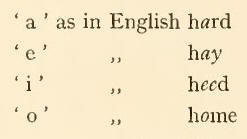
and
probably the consonants should be given their Gaelic equivalents also
(all which can best be obtained verbally from a Gaelic speaker).
In addition to the simple vowels, combinations
occur which require to be sounded as diphthongs:

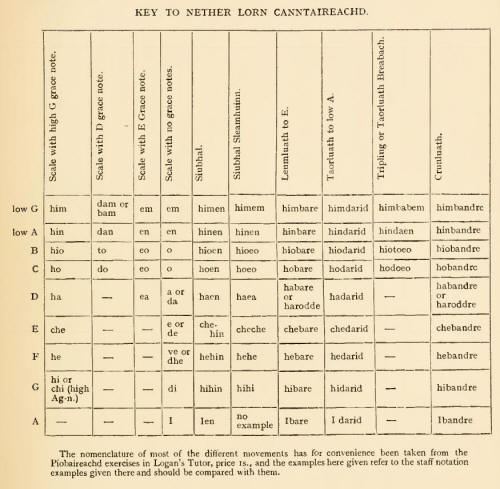
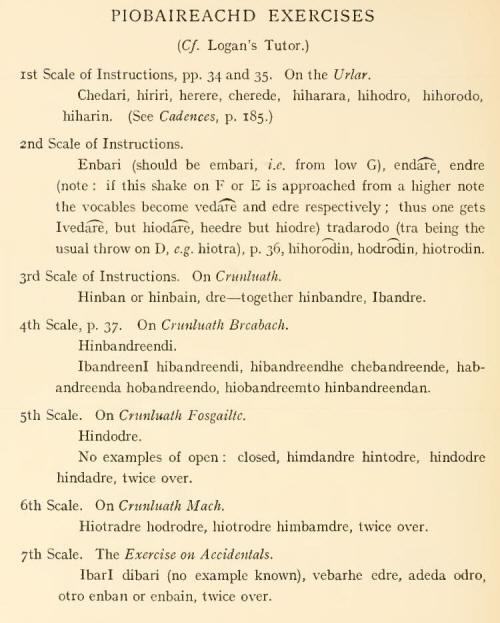
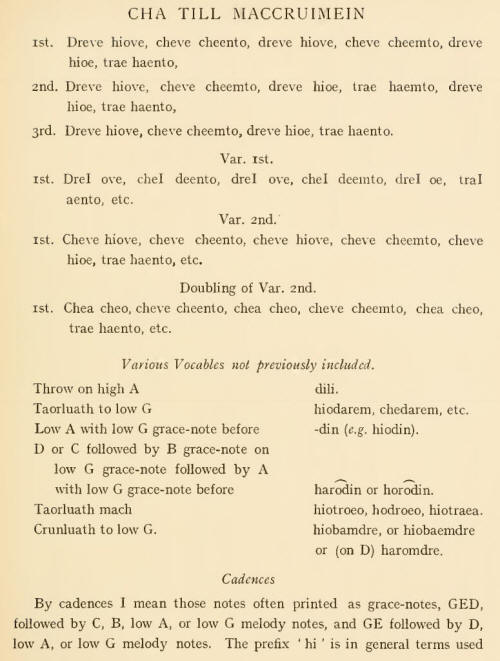
for this, e.g. hiharin, hihorodin. Taking them in
above order, examples of the vocables used are, of the former, iiihodin,
hihioern, hihinbain, and hiharnbarn, and of the latter hiaen, hienem,
hiemto. It is one of the remarkable points in the MS. that these
cadences are indicated to a far less extent than is played by
traditional players of modern times, and I am as yet unable to make any
deductions from the manner in which they appear as to the style in which
the MS. intends them to be played. To avoid confusion between ' hi ' as
cadence and high G with A grace-note, it would be better to use the
alternative ' chi' for the latter.
General
A study of the key will reveal various noticeable
points, some of which I will touch on here. It will be seen that some of
the composite vocables can be pulled to pieces into their component
parts, e.g., hiotroeo, hinbandre, etc., while others can only be
dissected to a lesser extent, e.g., hindaen in the Tripling or Taorluath
Breabach ; in this latter case the vocable must be read in its context,
for hindaento might be 6 low A, D, low A, B, while standing by itself,
but in conjunction with a string of others it is undoubtedly meant to be
the Taorluath Breabach. Again there is liable to be confusion between
'en 'low A without any and with an E grace-note, and in some few cases
it is impossible to say definitely which is meant omi the other hand it
is used in the siubhal variation, and there can be no doubt in such a
context hinen by itself is unambiguous, and in various combinations,
e.g., hiaendre, it is highly probable that no If grace-note is intended.
The question of the co and o, B or C, is a little more difficult in
theory, but in practice it will be found to narrow down to one or two
instances; the most common instance of this ambiguity is odro, which may
be either B grip C, or C grip C. It seems likely that this contusion is
the origin of this difference in existing settings of various tunes,
e.g., An Daorach Mhor (The Big Spree) Var. 1st and doubling, The Battle
of Auldearn, The Caries of Shigachin and many others. Campbell often
writes 'ho' for 'o,' obviously not intending a G grace-note, but to
avoid this ambiguity.
Time signature and rhythm are, I think-,
sufficiently shown to enable a trained player to find no difficulty in
playing; bar divisions are indicated by commas, and each part of each
tune is divided into lines numbered 1st, 2nd, etc. : and a repeat is
written at the end of the line to be repeated, thus : Two times or twice
over. ' 3 times,' etc., is often used in the MS. to refer back only to
the last comma, not to the beginning of the line. The smaller details of
time, which I will call " pointing," is a matter of greater doubt. I
have said above why I think Gaelic standards should be applied to the
pronunciation of the vocables, and my opinion is that the same applies
to this question in general terms: it can be said that as a rule the
vocables are separated into distinct words, the accent or stress (and in
this case the longer note) being represented as the first syllable of
the word (an almost invariable rule in Gaelic). Thus one gets hodarid
hiodarid—not daridho daridhio darid. Many exceptions can be pointed out
no doubt, but the above will serve as a broad rule.
It should be made clear to any reader of this
paper that it has been written in haste. Most of it is written from
memory after four and three-quarter years separation from MSS., books
and notes, and I have no doubt that mistakes will be discovered later.
Further, it does not profess to be complete, for there are some vocables
not included, the meaning of which is not yet clear to me.
The two volumes of the MS. contain 169 tunes of
which I can trace in no other collection, printed or MS., 65 tunes :
moreover, many tunes which exist already in printed collections are
written in entirely different settings, and under different names from
those known by present day players. To illustrate this I have included
at the end of this paper the MS. style of An Ceapadh Eucorach
(translated as the "Unjust Incarceration"). This setting, apart from
smaller differences, contains one line in each part which, so far as my
knowledge goes, is unknown to-day, and which in my opinion is an
essential part of the theme, leading the 3rd line up to the musical
climax of the ordinarily accepted 4th line.' The names of the tunes as
written in the Index or as headings in the MS. present a very difficult
problem. Some are in English; some are in recognisable Gaelic; some are
in unrecognisable Gaelic, some give the first few notes of the tune, and
some are ludicrous inistranslations of Gaelic into English. Only
approximately 42 out of the total have anything like time names by which
the tunes are known to-day.
It is to be hoped that sonic day soon the whole
MS. will be printed, so that enthusiasts who have the time may really
get to work and unravel some of the conundrums which still remain so. I
have a feeling that the vocables used in so many Gaelic songs are
distantly related to canntaireachd, and research into this might
conceivably throw light on the larger question of the origin of
canntaireachd. It would also be interesting to know of any examples of
similar notations in foreign countries. But the main thing to be done by
all pipers at the present day is to make real attempts to discover other
canntaireacbd manuscripts : and the ideal should be that all MSS. now
known to exist or discovered at a later date should be made available
for comparison and information of other players this is best clone by
publication in as near the original form as possible, and failing that
by loan or gift to some responsible piping society, such as the Scottish
Pipers Society, The Piobaireachd Society, the Caledonian Pipers Society,
London, The Inverness Pipers Society, The Highland Pipers Society,
Edinburgh, or any other well-known society. This would ensure that the
information would get into the hands of those who can most easily
disseminate it.
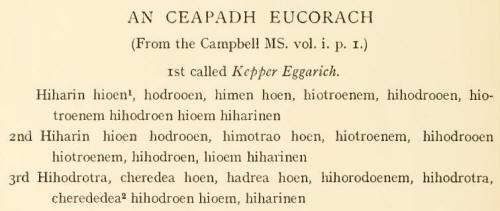
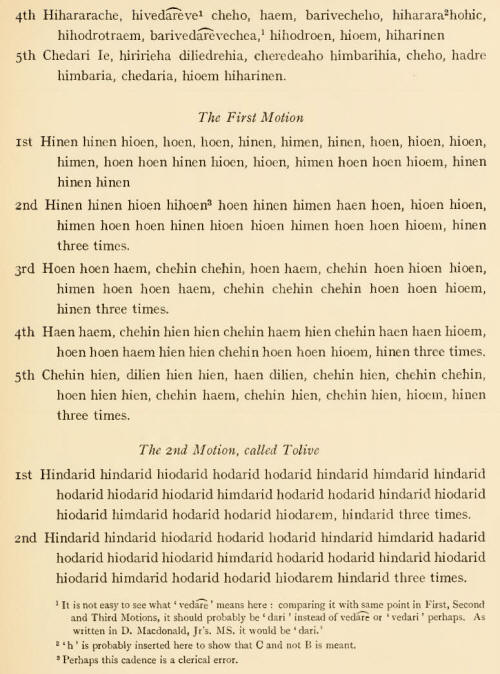
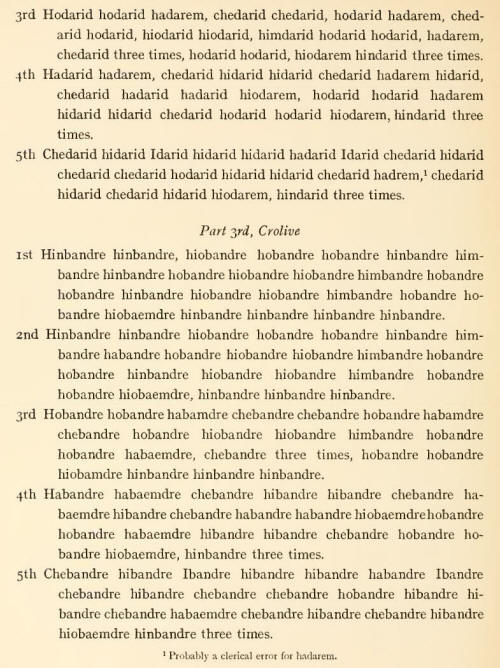 |

